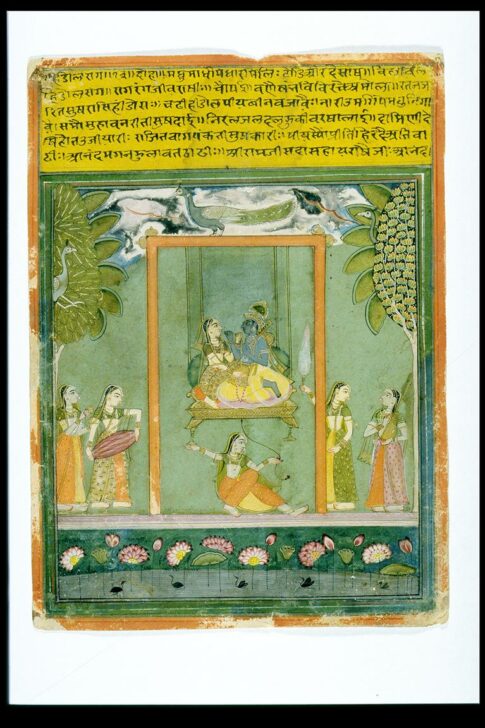Ragamala series: Hindola Raga (folio no. 13?)
Artist Unknown, India, Rajasthan, Jaipur School

Description
Hindola means swing, so a swing is usually the dominant motif in paintings of the Hindola Raga. Here the artist has depicted the raga as none other than Krishna (an incarnation of the Hindu god Vishnu) on the swing with his beloved. A young woman pulls on a cord from below to rock the swing, while female musicians set the tempo. The scene is neatly framed by a stormy sky above, stylized trees with resident peacocks on either side, and a lotus pond below. The cool colors and water motifs suggest the rainy season, traditionally the time of year for swinging. This setting is appropriate for a raga meant to be sung on a spring morning. Paintings from this ragamala set are inscribed with two poems, one long and one short, on their respective themes.
Exhibited in "Divine Encounters, Earthly Pleasures: Twenty Centuries of Indian Art," 12/12/03-2/22/04.
Subject Matter:
Ragamala paintings draw from aspects of human experience in order to visualize specific moods, emotions, and qualities such as love, anguish, valor, weakness, and strength. A raga in Indian music is a melody consisting of a string of notes in a particular arrangement. Raginis are derivations from or variations of ragas in feminine mode (the basis of these classifications remains unexplained in many cases), and could have different or similar musical structures as ragas. Specific ragas are associated with specific times of the day, seasons, and emotions. When visualized, as here, ragas and raginis are meant to evoke the same affective responses that are allied to their musical modes. The text above the illustration refers to stories or incidents associated with the depicted raga/ ragini, but may not necessarily be narrative-like or descriptive. Drawn from literary tropes and tales that sophisticated writers and viewers would be aware of, the inscriptions are an integral part of the overall experience of this miniature painting. An illiterate viewer, however, could still enjoy the scene without reading the text.
Hindola means swing, so a swing is usually the dominant motif in paintings of the Hindola Raga. Here the artist has depicted the raga as none other than Krishna (an incarnation of the Hindu god Vishnu) on the swing with his beloved. A young woman pulls on a cord from below to rock the swing, while female musicians set the tempo. The scene is neatly framed by a stormy sky above, stylized trees with resident peacocks on either side, and a lotus pond below. The cool colors and water motifs suggest the rainy season, traditionally the time of year for swinging. This setting is appropriate for a raga meant to be sung on a spring morning. Paintings from this ragamala set are inscribed with two poems, one long and one short, on their respective themes.
Physical Description:
Blue bodied Krishna is shown on the swing with Radha. A peacock stands above the swing frame, and two other peacocks are shown, peering out of the trees shown on the left and right. Five attendants surround the divine couple. One holds the string that, when drawn, will provide the swing its motion; three hold musical instruments, and the fifth a fly whisk. The setting is an open-air garden-like space, with lotuses in the water depicted below the human figures.
Usage Rights:
If you are interested in using an image for a publication, please visit https://umma.umich.edu/request-image/ for more information and to fill out the online Image Rights and Reproductions Request Form.